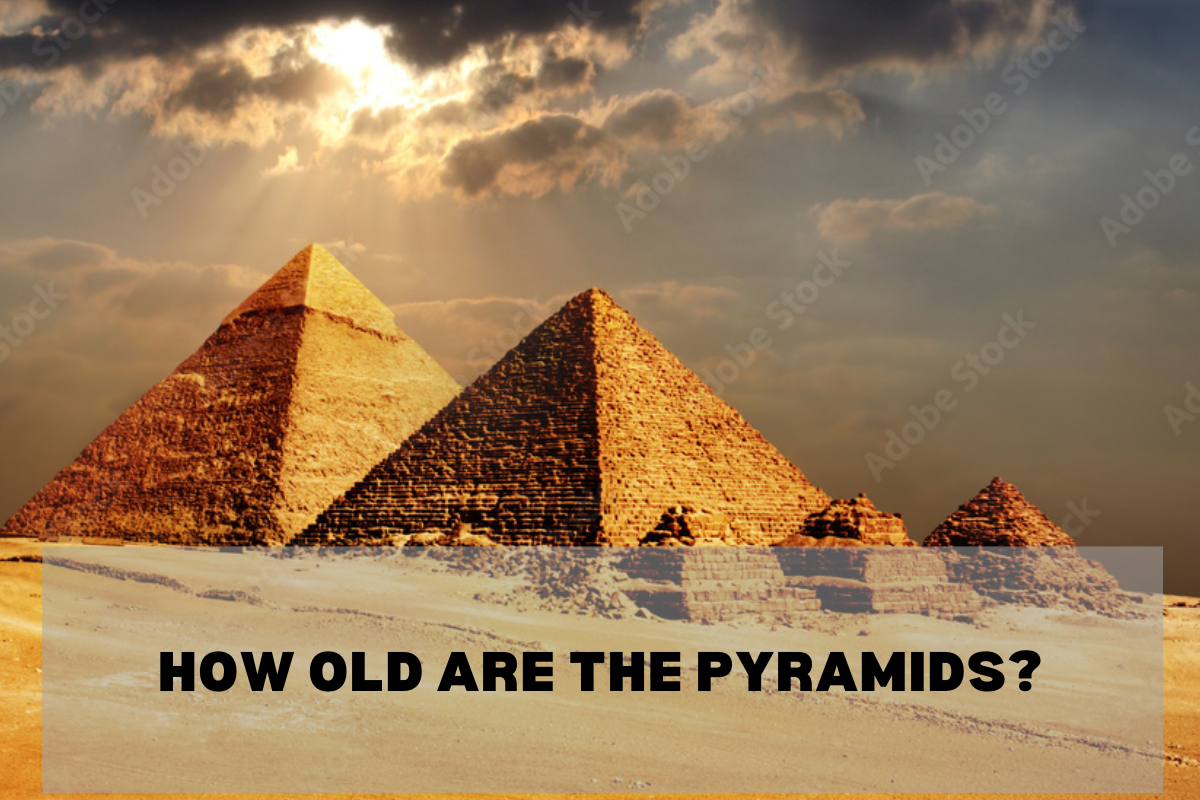How Old Are The Pyramids?
Introduction

Archaeologists believe that Egypt’s large pyramids were built by the Old Kingdom society, which rose to prominence in Egypt’s Nile Valley after 3000 B.C. Historical analysis shows that the Giza Pyramids were built by the Egyptians between 2589 BC and 2504 BC.
Popular and academic circles are both interested in Egyptian chronology. Science was used to verify the historical dates of several Old Kingdom monuments.
Previous estimates
C14 is a radioactive or unstable carbon isotope. It decays over time, providing scientists with a clock to measure the age of organic materials.
The first radiocarbon dating experiments were made with ancient Egyptian material. Willard F. Libby and his team obtained acacia from the 3rd Dynasty Step Pyramid at Djoser in order to test a hypothesis that they had created.
Libby argued that C14’s half-life was 5568 years so the Djoser sample should have a C14 concentration of about 50%. (For more information, see Arnold and Libby 1949). Their hypothesis was confirmed by the results.
Radiocarbon testing was used to answer questions about atmospheric C14 fluctuations over time. These fluctuations have been adjusted for by scientists using calibration techniques.
What’s radiocarbon dating?
Carbon atoms are the building blocks of all living things. There are many species or isotopes of carbon atoms that have the same atomic number, but different masses.
C14 is a radioactive or unstable carbon isotope. It decays over time, providing scientists with a way to measure the age of organic matter.
All living organisms take C14 into their body. The organism’s lifetime will see the same number of C14 atoms as non-radioactive C atoms. Carbon uptake ceases when a plant or animal is dead. Radioactive carbon isotopes are no longer replenished. They only decay.
Scientists have determined the rate at which C14 begins to decay. We can determine the age of an organic material by measuring the amount of C14 that remains.
Radiocarbon dating is not possible on samples older than 50,000 years. The remaining C14 in the sample is too small to date. Radiocarbon dating is possible for material from the time the pyramids were built, as they are within the 2575-1640 range.
Wood and wood charcoal are preferred by radiocarbon technicians to be tested because of their high molecular mass. This prevents material loss during rigorous pretreatments that are required for radiocarbon testing. Our collection efforts were focused on small pieces of these materials as well as straw and reed left behind by ancient builders.
1984

Project members collect samples
Radiocarbon dating was conducted on Egyptian Old Kingdom monuments in 1984 by Edgar Cayce Foundation supporters and friends. The results were then compared with the mid-point dates for the kings to which the monuments belonged (Cambridge Ancient History 3rd Ed.). ).
The average radiocarbon date was 374 years earlier than anticipated.
Despite this discrepancy however, radiocarbon dates confirmed the Great Pyramid belonged in the historical era that Egyptologists have been studying.
1994-1995
The David H. Koch Foundation supported radiocarbon dating in 1994-1995.
Our sampling was expanded to include material from:
- Saqara, 2920-2770 BC: The 1st Dynasty Tombs
- The Djoser pyramid (2630-2611) BC
- The Giza Pyramids (2551-2472BC).
- A selection of 5th Dynasty Pyramids (2465-2323 BC).
- A selection of 6th Dynasty Pyramids (2323-2150 BC).
- Below is a selection of Middle Kingdom pyramids (2040-1640 BC).
We also collected samples from the Giza Plateau Mapping Project Lost City excavations (4th Dynasty), which revealed two intact bakeries that were established in 1991. The charcoal and ash deposits left by ancient baking are extremely useful for dating.
The 1995 radiocarbon dates were 100 to 200 years older that the Cambridge Ancient History dates. This was approximately 200 years earlier than our 1984 dates.
you may want to read: How To Use Crystal Pyramids: Ultimate Guide To Uses And Healing Benefits
Comparison 1984/1995
Only a small number of dates were available from both projects to permit statistical comparisons between the pyramids at Djoser and Khufu, Khafre, Menkaure.
Two striking results are found.
First, there are significant discrepancies in the 1994 and 1995 dates of Khufu, Khafre, but not Menkaure and Djoser.
Second, even for one monument, the 1995 dates can vary greatly. They scatter over a distance of approximately 400 years for Khufu’s Great Pyramid.
Date agreements

There is a fair agreement between our historical dates and previous radiocarbon dates for the 1st Dynasty North Saqqara tombs. We also agree with our radiocarbon dates using reed materials.
A fair agreement also exists between our radiocarbon dates and the historical dates of the Middle Kingdom. Eight calibrated straw dates from Senwosret I (1897-1878 BC), ranged in age from 103 to 78 years earlier than historical dates.
Four Senwosret II dates were within 30 to 24 years. The other three were within 14 and three years. The older date was on charcoal, which is significant (see “old-wood issue” below).
Results from Middle Kingdom pyramid (Senwosret II).
Or you might want to read: How To Use Crystal Pyramids
The problem with old-wood
The population of Ancient Egypt was confined to the Nile Valley, which is surrounded by a thin forest. It is possible that the Egyptians were already using wood as fuel since the pyramid age.
The Egyptians used wood in a variety of ways due to its scarcity and high cost.
For example, some of the recycled wood was used in mortar preparation.
Radiocarbon dates for the charcoal would indicate that the wood used to make the mortar was centuries old at the time it was burnt.
It seemed unlikely that pyramid builders used centuries-old wood to make mortar.
We were unable to determine if the Old Kingdom chronology was correct by almost 400 years from the 1984 results, but this was at least an option.
Alternately, if our radiocarbon estimates were incorrect for some reason, then we had to assume many other dates from Egyptian materials were also suspect. This led to the second, more extensive 1995 study.
The problem in the Old Kingdom

The Middle Kingdom radiocarbon dates seem to be good. But why is the Old Kingdom radiocarbon date from pyramids so difficult?
Many times, pyramid builders used cultural materials from the past to connect with their pharaohs and their predecessors.
Early explorers discovered more than 40,000 stones beneath the 3rd Dynasty pyramid built by pharaoh Djoser.
The vessels contained inscriptions from most of the kings in the 1st and 2nd Dynasties. However, Djoser’s name was only one of these. Djoser gathered and reused vases already 200 years old from North Saqqara’s tombs.
This type of recycling was clearly demonstrated by Amenemhet II (1991-1962 BC), in the 12th Dynasty.
He took fragments of Old Kingdom tomb chapels, and pyramid temples (including the Giza Pyramids), and dumped them in the core of his pyramid at Lisht.
Results from the 5th Dynasty pyramid, Sahure
Three of the eight radiocarbon dating dates taken from the excavation at the Lost City almost match Menkaure’s historical dates, 2532-2504 BC. The remaining five dates range from 350-100 years old.
Radiocarbon analysis from the Lost City site suggests that charcoal dates scatter widely and are similar to those found in pyramids. Many dates are older than historical estimates.
During the 85 years they built pyramids, it is very possible that the inhabitants recycled their settlement materials.
Conclusions
In our 1984 study, it may have been premature for us to ignore the problem with old wood. Radiocarbon dating cannot tell us when a tree died and not when it was last used. In dry climates like Egypt, wood can remain for centuries without being used.
Any living forest will also have very young trees and shoots. Each tree will have both old and young parts (the inner rings)
Are our radiocarbon dates consistent with the Old Kingdom deforestation in Egypt?
Did the pyramid builders use every bit of wood they could get?
Did they have to find wood to make mortar, forge copper chisels and bake bread for thousands?
One possible reason for the massive stone pyramids found in Egypt’s early Old Kingdom is the depletion of Egypt’s wood resources. This could explain the Old Kingdom’s widespread and unfriendly radiocarbon dating results.
Despite the difficulty of estimating the age of pyramids due to the many old-wood effects, the David H. Koch Pyramids Radiocarbon Project has us considering forest ecologies, site formation process, ancient industry, and their environmental impact.
In sum, we are looking at the society and economy that left the Egyptian Pyramids as a legacy for all humanity.
The David H. Koch Pyramids Radiocarbon Project is a joint effort of Shawki Naakhla and Zahi Hawass. Ancient Egypt Research Associates, Inc. managed the project.
Also see: Bonani G. Haas H. Hawass Z. Lehner M. Nakhla S. Nolan J. Wenke R. Wolfli W. Radiocarbon 43, No. 3 (2001), 1297-1320(24).




